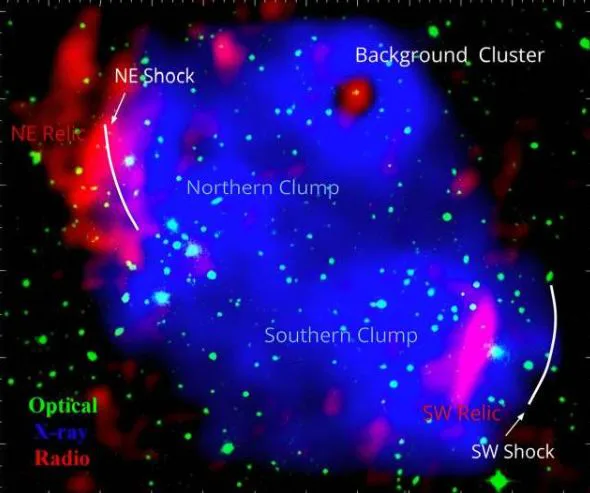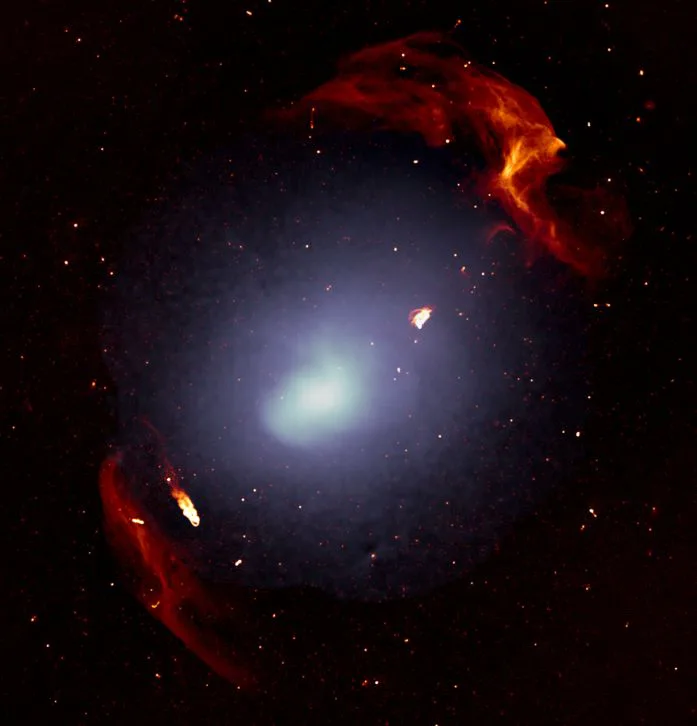
Indian and Taiwanese astronomers recently upgraded Giant Metrewave Radio Telescope (uGMRT) to snoop around the galaxy cluster Abell 2108. And guess what? They stumbled upon a second, way bigger radio relic that’s like, totally different from the first one they knew about in the same cluster.
The Wonders of Synchrotron Radiation
Radio relics are like stretchy, glowy radio sources born from synchrotron vibes. In simple words, the radiation is produced by charged particles as they undergo acceleration or change direction. This acceleration results in the emission of electromagnetic radiation, including radio waves. The process is also called as synchrotron radiation.
These radio relics grace galaxy cluster edges in stunning arcs. Astronomers focus on finding double relics for key insights into cluster mergers and emitted outcomes.
Scattered radio happenings, whether flying solo or hanging out in pairs, unravel secrets of cosmic collisions, cluster mergers and the resultant emission.
A Fresh Radio Relic in Abell 2108
Abell 2108, aka A2108, a cosmic hotspot with a redshift of 0.09. This cluster is no lightweight; it’s carrying a mind-blowing 301 trillion solar masses.
In the southwest corner, there’s this massive radio relic stretching across 980,000 by 390,000 light years, and guess what? It was uncovered in some previous cosmic snooping around.
Recently, Swarna Chatterjee and her team from the Indian Institute of Technology Indore just found a new radio relic in Abell 2108.
Brace yourself because this discovery transforms A2108 into one of the rare low-mass galaxy clusters sporting not one, but two radio relics.
Funky Emissions in Abell 2108
Chatterjee’s crew didn’t just stumble upon any old thing – they found this funky diffuse emission vibe in the northeast of Abell 2108.
The brightest part of this thing is like 1.4 million light years away from the cluster’s X-ray center. And guess what? It’s giving off serious radio relic vibes!
But hold on, there’s more! This new radio relic isn’t your typical run-of-the-mill. It’s got this patchy structure, totally different from the ones we already know, and get this—it’s massive! We’re talking two by one million years of cosmic real estate.
Oh, and the numbers are in—the northeastern relic is rocking an integrated flux density of 24.8 mJy, which is more than double the southwestern one. Talk about turning up the radio relic game!
Abell 2108’s Shy Glow, Big Surprise
Hold on to your telescopes, folks! So, Abell 2108’s radio relics? They’re like the quiet ones at the cosmic party with surprisingly low radio power at 1.4 GHz, especially when you throw them into the ring with other double relic clusters. And get this, the brightness on their surfaces is playing cosmic twister, hinting they might not be from the same stellar family.
But wait, there’s a plot twist in the northeastern relic! Astronomers caught a surface brightness jump and a maybe-temperature jump right in the middle. It’s like a cosmic mic drop signaling a weak supersonic shock. And why is this cool? Well, it could be the reason the newfound relic’s radio glow is a bit on the shy side.

Takeaway
Understanding how multiple relics coexist and interact can unveil valuable insights into the cluster’s history and the processes shaping its structure.
Future studies might dive into virtual cosmic realms with simulations and models. It’s like creating a digital sandbox to play around and decode the cosmic magic that births these relics.
The coming years are likely to witness a surge of exploration, with astronomers unraveling the mysteries hidden within Abell 2108’s cosmic tapestry.
Source: Phys.org



